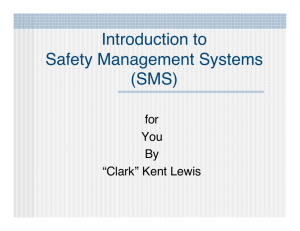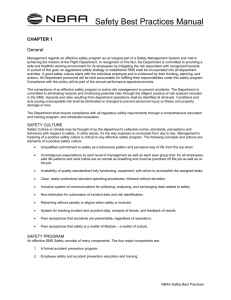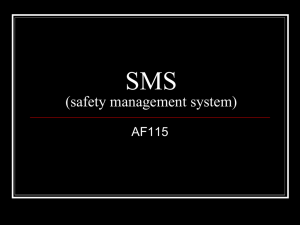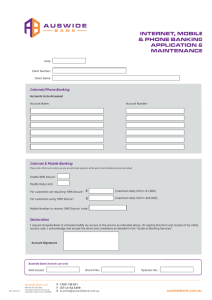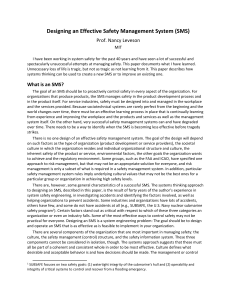Regional Aviation Safety Manager Newsletter Vol. II
advertisement
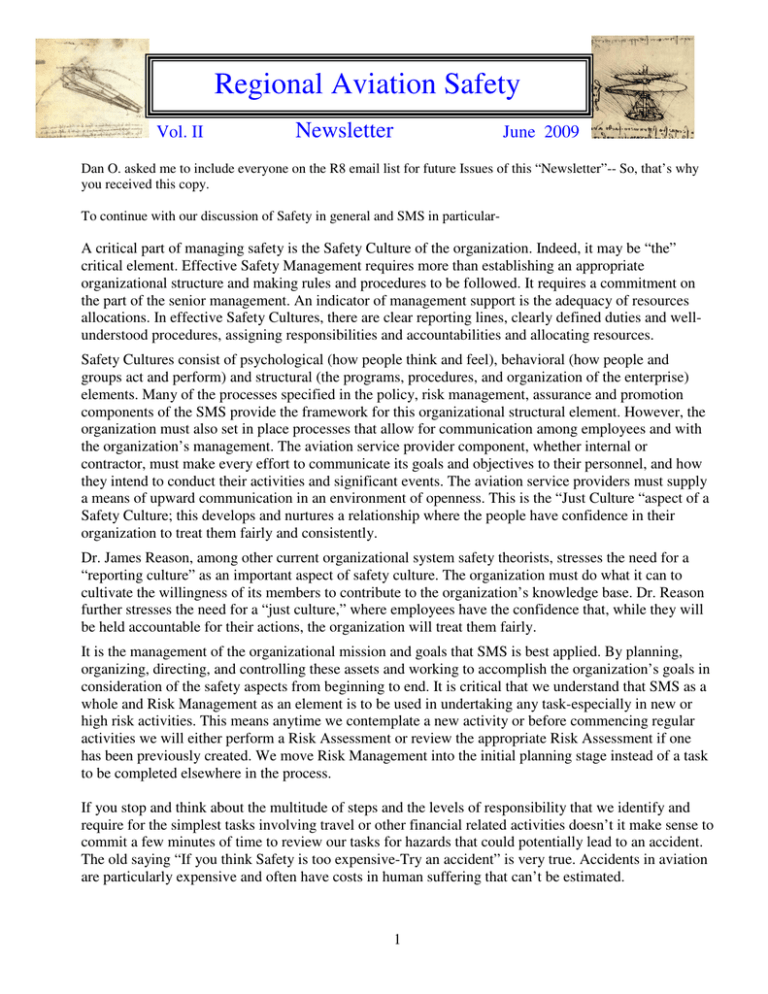
Regional Aviation Safety Manager Newsletter Vol. II June 2009 Dan O. asked me to include everyone on the R8 email list for future Issues of this “Newsletter”-- So, that’s why you received this copy. To continue with our discussion of Safety in general and SMS in particular- A critical part of managing safety is the Safety Culture of the organization. Indeed, it may be “the” critical element. Effective Safety Management requires more than establishing an appropriate organizational structure and making rules and procedures to be followed. It requires a commitment on the part of the senior management. An indicator of management support is the adequacy of resources allocations. In effective Safety Cultures, there are clear reporting lines, clearly defined duties and wellunderstood procedures, assigning responsibilities and accountabilities and allocating resources. Safety Cultures consist of psychological (how people think and feel), behavioral (how people and groups act and perform) and structural (the programs, procedures, and organization of the enterprise) elements. Many of the processes specified in the policy, risk management, assurance and promotion components of the SMS provide the framework for this organizational structural element. However, the organization must also set in place processes that allow for communication among employees and with the organization’s management. The aviation service provider component, whether internal or contractor, must make every effort to communicate its goals and objectives to their personnel, and how they intend to conduct their activities and significant events. The aviation service providers must supply a means of upward communication in an environment of openness. This is the “Just Culture “aspect of a Safety Culture; this develops and nurtures a relationship where the people have confidence in their organization to treat them fairly and consistently. Dr. James Reason, among other current organizational system safety theorists, stresses the need for a “reporting culture” as an important aspect of safety culture. The organization must do what it can to cultivate the willingness of its members to contribute to the organization’s knowledge base. Dr. Reason further stresses the need for a “just culture,” where employees have the confidence that, while they will be held accountable for their actions, the organization will treat them fairly. It is the management of the organizational mission and goals that SMS is best applied. By planning, organizing, directing, and controlling these assets and working to accomplish the organization’s goals in consideration of the safety aspects from beginning to end. It is critical that we understand that SMS as a whole and Risk Management as an element is to be used in undertaking any task-especially in new or high risk activities. This means anytime we contemplate a new activity or before commencing regular activities we will either perform a Risk Assessment or review the appropriate Risk Assessment if one has been previously created. We move Risk Management into the initial planning stage instead of a task to be completed elsewhere in the process. If you stop and think about the multitude of steps and the levels of responsibility that we identify and require for the simplest tasks involving travel or other financial related activities doesn’t it make sense to commit a few minutes of time to review our tasks for hazards that could potentially lead to an accident. The old saying “If you think Safety is too expensive-Try an accident” is very true. Accidents in aviation are particularly expensive and often have costs in human suffering that can’t be estimated. 1 An effective Safety Management System includes four key elements; they are even referred to as “Pillars” of SMS. They are: S a f et y M a n ag e m en t S y s t em Promotion Risk Mgmt Culture Assurance Safety Policy Safety Assurance Risk Management Safety Promotion Policy • • • • We should identify these elements in regard to what we expect to be accomplished and by whom in our organization. Safety Policy includes the management commitment, responsibility, and accountability. We can see the initial commitment from senior management as represented in the adoption of SMS as the way the Forest Service(FS) intends “to do business”. The basic elements of an SMS are already integrated into the FS Aviation Safety Program, so we will be working to improve their application and functionality. There will be additional ways to identify this commitment as we move to a more policy documented stage of SMS. Safety assurance is where we monitor and measure safety performance, the audits and surveys we use to change management and continuously improve our program. Safety Assurance is accomplished by utilizing the various tools we have available to continually measure and assess our status in relation to maintaining our level of desired protection. They include inspections, audits and surveys. They need to be performed on a regular basis and by individuals with experience that allows them to identify problem areas and expose potential hazards before they can become a threat to safety. Systems Model SAFETY MANAGEMENT ERROR SAFETY PROGRAM DEFECT SUPERVISION ERROR Systems Model • • • • • • Person Training Task Machine Environment Situation SYSTEM DEFECT RESULT MISHAP OPERATING ERROR When we conduct an audit or inspection we use a “Safety Focused Perspective”. This includes the use of Guides and Checklists, but more importantly it includes the insight of a trained safety professional Protect By Managing Risk Safety Promotion is interesting because it’s a sequence that develops as a result of the Safety Culture and it is a component generated by the Safety culture. When the organization’s Safety culture is functioning correctly we see the Senior Management’s commitment to safety and SMS, there is clear and regular communication of policy, goals, objectives, standards and performance to all employees, and there is feedback, confidential if desired, that allows the retrieval and use of information collected to improve safety performance. Dr. Reason says managing safety is like fighting a guerilla war, where there are no final victories. It’s a never-ending struggle to identify and eliminate or control hazards. We’ll never run out of things to do to make the system safer. Our goal is to identify the ways to make the system safer, decide how to achieve them and hold ourselves accountable for achieving them. Another of Dr. Reason’s principles of organizational safety culture is that of a “learning culture.” The information in reports, audits, investigation, and other data sources does no good if the organization does not learn from it. The standard also requires a means of analysis of this information and a linkage to the safety assurance process. The standard requires an analysis process, a preventive/corrective action process, and a path to the safety risk management process for the development of new safety controls, as environments change and new hazards are identified. It further requires that the organization provide training and information about risk controls and lessons learned. 2 The Risk Management element of SMS is also found in the current FS Aviation Safety Program and our goal is to enhance its use by improving the elements of RM as a tool. To make it easily understood and more user friendly in its application. The Safety Office will be publishing a comprehensive Risk Assessment (RA) of aviation activities, to be used as a guide and to assist individuals, performing Risk Assessments, in identifying hazards in the activities they engage in. The basic RA procedure helps us determine where the greatest risks are and set priorities for mitigation. The priorities then become our goals and we can concentrate on identifying and reducing or removing them as precursors to accidents. The worst hazards are those that lie within our system as latent weaknesses waiting to combine with other elements and hazards to produce an accident. It is this function of SMS that I find the greatest source of benefit and tangible action that can be translated into accident prevention. The application of Risk Management to any undertaking will enhance and improve that action. Whether we pursue business or financial benefits, or we want to make an activity safer, Risk Management is the tool for the job. When we review, audit and inspect we need to keep Risk Management in the process in order to contemplate the boundaries of an activity. We sometimes apply the term “what-if” to an exercise of Risk Analysis and that is a very useful method of getting a perspective that will encompass all the various events in any undertaking. It is much better to have thought or planned an activity from beginning to end than to be in the middle of something and realize that you never considered the circumstance you are encountering. Risk Management allows us to identify hazards, assess their impact and mitigate or remove them. This is a goal for the entire organization, its Divisions, Programs and Contractors, as well as, to the individuals within an organization. For myself, I appreciate having important elements identified as goals. This allows me to focus the necessary time, energy and resources to make them successful. Few organizations are good at developing Safety Goals. The most common problem is that we tend to focus on outcomes. Usually this means counting accidents. Safe organizations can have accidents while less safe organizations can be lucky and avoid accidents. But, if we don’t set tangible goals then we learn less about our systems - until we have an accident. At the time of this writing the aviation authorities are trying to piece together the facts surrounding the French Airbus crash in the Atlantic between Rio de Janerio and Paris. The facts emerging are pointing to a break-up in flight due to weather. The flight path took the airliner through an area of the world’s strongest storms. One writer characterized the crash as a plane in an unequal fight with Mother Nature. If I were contemplating a flight in that area a simple Risk Assessment would yield the information needed to help me make my mind up on whether to fly or wait for better weather. The zone in question has predictable weather patterns and to maximize your chances of avoiding the bad weather you just need to be aware of these schedules. It is an inconvenience and some of the experts say it is unnecessary to take the phenomena into account when scheduling flights. I know what I would do. But, how many people rely on Risk Management to the extent that they would think to do a Risk Assessment of a flight. If we achieve the kind of Safety Culture we are hoping for-you will all be doing Risk Assessments for everything you do - work and leisure. In flying I have learned that carelessness and overconfidence are usually far more dangerous than deliberately accepted risks. — Wilbur Wright in a letter to his father, September 1900 3
